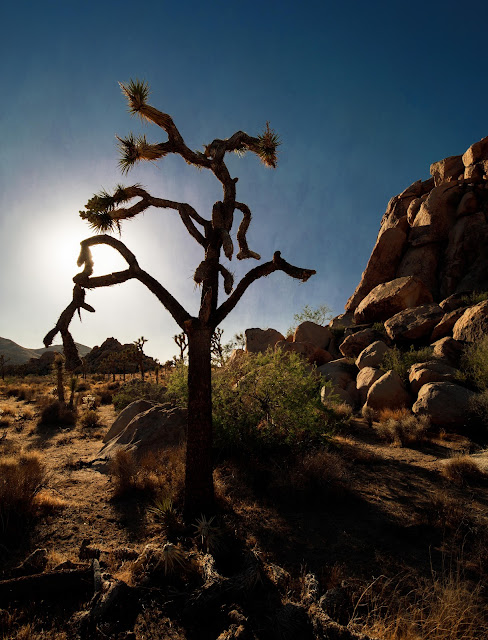If you are driving through Joshua Tree National Park and looking for a nice spot to stop to stretch your legs or have a picnic, it's hard to beat Quail Springs Picnic Area. Its rock formations make it one of the prettiest spots in the Park. I've stopped here many times over the years, but never hiked the area. On this hot summer day, I was looking for a short(ish) hike that I could do solo, at a higher elevation in the Park (cooler temps), and that wouldn't be too demanding. Hiking south out of Quail Springs Picnic Area seemed perfect.
 |
| A beautiful blue sky day in Joshua Tree! |
Hiking south, it wasn't long before I reached these interesting boulders. A nice spot to explore and see what I could find.
 |
| Sleeping tortoise? |
I came across these interesting petroglyphs. If you look really closely, you can see a couple bolts in the rocks. I suspect this area was used for livestock back in the day, and the bolts anchored some kind of fencing. The petroglyphs look like initials (from the old-timers who ranched in the area?) rather than Native American symbols.
The area with the bolts is surrounded on either side by boulder formations, which might have formed two sides of a natural corral.
Historical trash. Some of these cans likely date back to the 1920's and '30s.
 |
| More bolts |
Hiking further south along the rocks, I come to what the climbers call the "White Cliffs of Dover". No passport required!
 |
| Reminds me of a bottle opener. |
 |
| I see a smiley face! |
From a distance, I thought for sure I had discovered a cool new pictograph site. The lichen fooled me!
At this point on the trail, limber hikers can duck under this Joshua tree and continue on. I chose to go around.
Continuing on with my hike, the sun was getting lower on the horizon and the light on the rocks more golden. Very pretty!
 |
| Monochrome version |
I love this late afternoon desert light and long shadows. Not sure if I prefer the monochrome or color version of this one, so sharing both.
With the sun getting lower on the horizon, it's time to hightail it back to the car. This is my favorite time of day to take pictures, and I'll share some sunset photos from this hike on my next post.
Linking with Skywatch Friday.
Thanks for stopping by!!























































